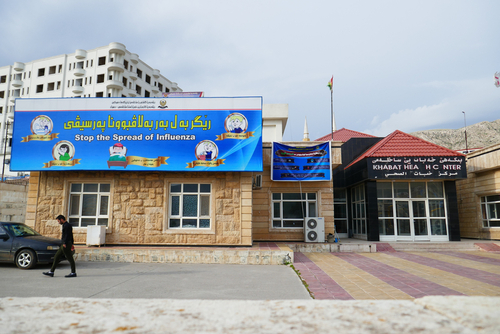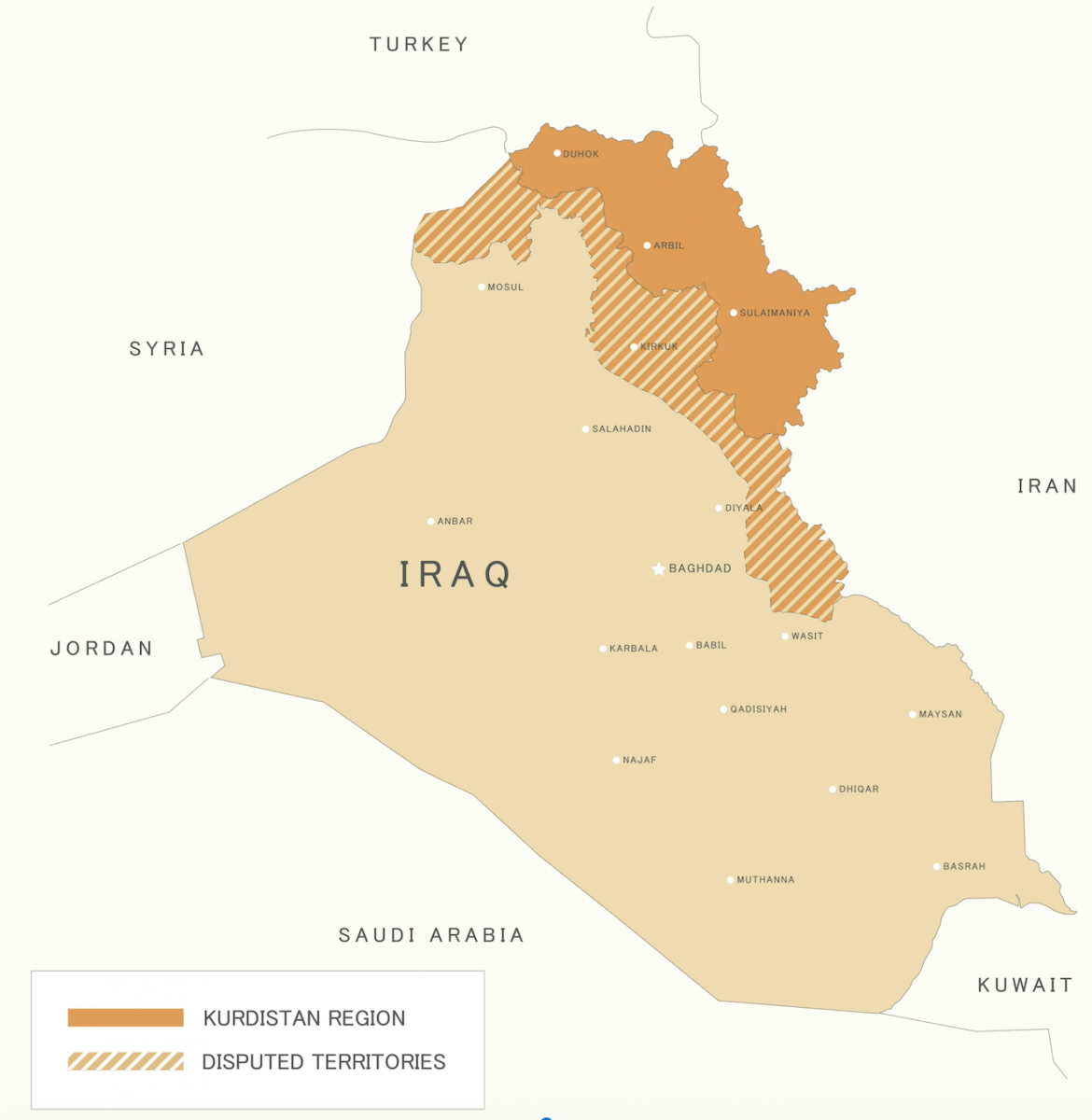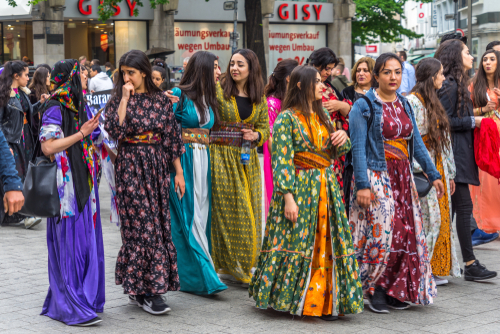COVID-19, Gender and Cyber Violence in the Kurdistan Region
Dr Nazand Begikhani, Vincent Wright Chair & Visiting Professor at CERI & PRESAGE-Sciences Po, Paris

COVID-19, Gender and Cyber Violence in the Kurdistan Region [1]
In the last few weeks and in the context of the COVID-19 lockdown, media outlets around the world have reported an increase in domestic violence, violence against women and cyber violence. While UN agencies, the EU and some governments have warned against domestic violence and proposed measures to prevent and protect victims, little has been done in relation to cyber violence.
Disease outbreaks affect men and women differently and it is important to identify the extent and the nature of gendered impacts on physical, emotional and psychological health on individuals and communities.[2] Coronavirus has forced all of us to stay home and has created a challenging situation filled with fear and uncertainty, which in many countries has led to depression and violence. Mainstream media recently highlighted that during the lockdown domestic and gender-based violence has increased across the world. For example, in Brazil domestic violence has increased by 50%; in Catalonia an official helpline is 20% busier and in Cyprus, calls to a similar hotline rose 30% in the week after 9 March, when the island had its first confirmed case of coronavirus.[3] In Britain, the number of women murdered by their partners has doubled from two to four per week since the lockdown started belatedly on 23 March.[4] In France, according to official statistics, domestic violence has risen by 36%.[5] The French government has invited women to report confidentially on domestic violence in local pharmacies and supermarkets by using a special code word. The situation is even more alarming in war-torn countries, in poor areas and among isolated groups, such as within communities of asylum seekers, migrants and refugees.
COVID-19 Lockdown and Cyber Violence
At this stage of the outbreak, it is difficult to conduct field work and produce evidence-based data on the extent, internal dynamics and the nature of gender-based violence (GBV) practised against girls and women in the Kurdistan Region of Iraq (KRI), called KR hereafter. However, in addition to media reports, different forms of cyber violence are visible and have been outlined.[6]
Cyber violence includes different forms of online behaviour targeting women and girls, intended to intimidate, to coerce, to cause fear, anxiety, humiliation, and extreme emotional distress. According to the US definition, certain forms of cyberstalking can lead to severe injury, increasing risks of suicide and even murder of targets.[7] Cyber violence can take many forms, including rude and hateful comments, bullying messages, threats, hypersexualised or pornographic images and surveillance through email, messaging apps and social media platforms, including Twitter, Facebook, Instagram, Viber and WhatsApp.

Duhok, Kurdistan Region, Iraq, 27 March 2020. Copyright: Shutterstock
What is more, during lockdown, people spend more time online and many women and girls conduct their work and pursue their studies through video conferences and internet platforms. Cyber-abusers have taken this opportunity to launch attacks targeting women, girls and children. According to UN Women, during the movement restrictions of COVID-19, the use of online platforms has increased and has been used by some as an opportunity to groom women in particular, and young people in general into exploitative situations.[8]
Traditionally, cyber violence targets women and girls because of their identity, based on their gender, sexual orientation, political and/or social activism, religious practices, or simply for personal reasons (refusing to date a man, leaving a boyfriend, or divorce, etc.). Furthermore, in the context of COVID-19, women working in the health sector, particularly in residential care and nursing homes, have been stigmatized for carrying the virus, transmission risks of which made them especially vulnerable to online threats. These forms of violence and coercive control start by constructing an identity of the targeted person as the ‘Other’, who is different from ‘Us’ and thus represents a danger to the collective identity and its well-being.
Last month, UN Women published a report stating that “…before Covid-19, one in 10 women in the European Union reported having experienced cyber violence since the age of 15, including having received unwanted, offensive and sexually explicit emails or SMS messages, or inappropriate advances on social networking sites.”[9] UN Women quoted Europol by saying that online activity by those seeking child abuse material has increased during the Coronavirus lockdown. Examples of these forms of cyber violence include bullying messages, hateful comments, threats, video clips through Instagram, and unsolicited pornographic videos received while they are dialling into a social event via a virtual chat room.
COVID-19 and Gender-based Violence in the Kurdistan Region of Iraq
As in most countries around the world, during COVID-19 lockdown, women in KR have faced multiple forms of gender-based violence and discriminations. However, reports by local authorities claim that domestic violence has decreased during the lockdown. This is good news, but to what extent does the report[10] reflect social reality? Kurdistan is no different from the rest of the world; lockdown and the confined presence of men at home may well have put pressure on women who cannot call police or social workers. Also, there are no effective systems for collecting data on domestic violence during lockdown, let alone about cyber violence. Violence here is not only physical. It is also emotional, psychological and sexual, as defined by the UN.
The Kurdistan Region of Iraq is not a state, rather a semi-independent constitutional entity within the federal State of Iraq. It comprises three governorates in the north: Erbil, Sulaimaniya and Duhok with a multi-religious population of around 5 million, including Muslims, Yazidis, Christians and Yarsans. It borders Syria to the West, Iran to the East, and Turkey to the North.

Kurdistan region in Iraq. Copyright: Shutterstock
Since 1991 Coalition forces established a no-fly zone or ‘safe haven’ in ‘Northern’ Iraq, with the aim of protecting the Kurdish population against attack by Saddam Hussein’s regime.[11] In 1992, the Kurdistan Front, comprising various Kurdish political parties, held general elections establishing the Kurdistan National Assembly and formed the Kurdistan Regional Government (KRG).
According to the Iraqi Constitution, which was adopted following a general referendum in October 2005, the federated region of Kurdistan has judicial powers and can enact and implement criminal laws and procedure.[12] In 2007, the Kurdistan National Assembly ratified Justice Ministry Law number 13 which, along with the Kurdistan Judicial Council, is designed to strengthen the judicial authority in Kurdistan Region.
Gender Norms and Code of Honour
Prior to 1991, the population in KR had experienced 40 years of dictatorship under the Ba’ath regime with several consecutive wars. Ba’athist policy aimed at physical and cultural elimination of the Kurdish population, through Arabisation, destruction of four thousand villages, forced displacement, chemical gassing, mass exodus and the genocidal operation of Anfal.[13] This resulted in the destruction of all social, economic and political structures in the Region, a recurrent upsurge of tribal ideology and the rise of Islamic fundamentalism.[14] For many Kurds, attachment to language, tradition and cultural norms became a form of resistance against the Arabisation policy and was essential for the preservation of their identity.[15]
In the last two decades, more particularly after the fall of Saddam Hussein in 2003, a recognisable Kurdish women’s movement has emerged in KR, achieving a considerable level of progress, yet traditional gender roles and relations are still prevalent. As in most patriarchal societies, gender roles have been clearly defined with women having a lower status in the family and restricted interaction in public spaces. Traditional forms of arranged, early and forced marriages have yet to be uprooted, especially among the mainly uneducated rural and tribal populations. Female virginity upon marriage is a requirement, and women are expected to be prudent, show respect, politeness and obedience to men to the level of subservience. Women’s bodies and sexualities represent the family’s and community’s ‘honour’ with strict rules of conduct. Stepping out of long-established norms and ‘honour’ codes is perceived as shameful, devaluing women and their families. In order to regain a collectively perceived lost ‘honour,’ women (sometimes men also) have to be eliminated in what are called acts of ‘honour-based’ killings. A simple rumour can lead to sullying women’s public standing and reputation, and may end up in extreme forms of ‘honour-related’ violence, including murder.
The code of ‘honour’ is still inscribed in the Iraqi Penal Code permitting men to kill in the name of honour while, in the Kurdistan Region of Iraq, many articles of this code have been changed since 2000. These legal reforms by the Kurdistan Regional Government (KRG) came about as part of a widespread campaign by women’s rights activists to institutionalise gender issues, paving the way towards gender equality and social justice. Hence several new articles of the penal and personal status codes in KR (but not in the remainder of Iraq) have been amended, including prohibiting forced and early marriage, limiting polygamy by making it ‘conditional,’ and criminalising killing in the name of ‘honour,’ considering it as murder, now liable to life imprisonment. Attempts to modernise Kurdish society after 40 years of dictatorship, forced displacement and genocide, included building of shelters to protect women at risk of violence, and establishment of the General Directorate to Combat Violence Against Women and the High Council of Women’s Affairs. These initiatives also included setting up academic Gender Studies Centres, the first of which was founded in 2011 with the help of the University of Bristol.[16]
The Kurdistan Parliament also has the power to enact entirely new laws and, regarding cyber violence, it voted for Law number 6 in 2008, addressing defamation and inappropriate use of all modern means of communication. This law criminalises the misuse of such media, especially if it leads to “dishonouring” and “violating the private life” of individuals and/or puts them in danger.[17] Three years later, KR took the most important legal step to combat these difficulties, when the Kurdistan Parliament voted in June 2011 for Law number 8, the Combating Domestic Violence Law (CDVL), which criminalised domestic violence and female genital mutilation. However, according to a study started in 2008 by the University of Bristol’s Centre for Gender and Violence Research with ongoing expert observation until 2015, these laws had not met their ambition to become an effective legal instrument in combating gender-based violence and violence against women outside the home setting, such as in relation to harassment in the street and other public spaces.[18] What is more, the implementation of the new provisions has been challenged by conservative forces, including faith communities and the Islamic parties.

Kurdish girls and women in traditional dress at a demonstration in the pedestrian zone of downtown Hannover, Lower Saxony, Germany, 19 May 2018. Copyright: Shutterstock
Cyber Bullying During COVID-19 Lockdown
If statistics about domestic violence cannot be relied upon due to the lack of a robust data collection system, especially during the lockdown, cyber violence can be more easily traced. This is due to the nature of this form of violence, which—although practiced by anonymous perpetrators hidden behind their screens—is visible to the public and can also generate online support for the “victims.”
To give but one example, last month, a human rights activist, singer and advocate for gender equality, Dashni Morad, has been personally targeted while she was involved in voluntary work with the Barzani Charity Foundation (BCF), distributing food packages to vulnerable people in poor areas in the region. She received both anonymous and non-anonymous messages from cyber assailants falsely accusing her of “selling herself” and receiving favours, including “large sums of money and property” from the Kurdistan Democratic Party (KDP). This form of cyber bullying not only caused the targeted person severe psychological and emotional distress, but also aimed to dishonour her and tarnish her reputation in the community. As said earlier, since “honour,” as in most patriarchal settings, is centred around women’s bodies and sexuality, it unfortunately represents the most valuable “asset” in the collective imagination and such a message can even lead to murder in the name of “honour.”
These violent acts are deeply rooted in traditional patriarchal mentality and in gender inequality, reproducing gender stereotypes as well as social and political stigma. Also, opponents to the KRG often use historical antagonism between the two leading parties—the KDP and the Patriotic Union of Kurdistan (PUK)—accusing women of corruption and of sympathising with one party or another. Most of these accusations are based on false rumours, yet once any rumour is publicly disseminated, it creates unnecessary stress and a difficult, potentially dangerous social milieu for the women who have been insulted. So far, these cyber-attackers have worked effectively and caused intense psychological and emotional distress for many Kurdish women.
There is no doubt that there is a great deal of gender-related stigma, sexism, misogyny and hatred enmeshed with structural social and political violence. Women lacking strong family, political or tribal links and support are particularly vulnerable; they are caught up at the intersection of sexism, tribalism and structural violence, which is proportionally escalated during crises, such as the Coronavirus outbreak. Dashni Morad’s cyber persecution is the perfect example of such a scenario. She comes from a modest family background; her family fled Kurdistan in 1991 during the Ba’ath atrocities against Kurdish civilians, and they have been living as refugees in Holland since then. She returned to Kurdistan alone in 2007 aiming to contribute to the reconstruction of her homeland after decades of war and genocide. In addition to the abovementioned cyber bullying, she has also been targeted since the end of April through social media, receiving hundreds of stalking messages, sexualised images and video clips accusing her of “immodesty,” of not being a “genuine Kurdish woman” and bringing in “European lifestyle and perverting Kurdish norms and traditions.” Her body, and the way she dresses and appears in public have been pruriently scrutinised by cyber-attackers. Some of these messages are particularly distressing, giving the impression that they are seeking to kill her symbolically. Some of these perpetrators are known, but so far no one has been called to account. What is more, during the COVID-19 lockdown, gender roles are shifting and are challenging dominant male identity, so some men may well have become more aggressive and sought to exercise power through intimidation. One of the ultimate aims of cyber-attackers has been to place women under a system of control in order to silence and isolate them further. As said before, in a society where honour and reputation are seen as the most valuable capital for women, the overall aim of cyber attackers is to cause permanent dishonour as well as disgrace, which can lead to murder, be it symbolic or real.[19]
Conclusion
“Experience from past outbreaks shows the importance of incorporating a gender analysis into preparedness and response efforts to improve the effectiveness of health interventions and promote gender and health equity goals.”[20] Despite feminist advances in many domains, patriarchy is still the dominant functioning system in the world. Combined with the challenge of COVID-19, patriarchy has fostered a situation where sexism, gender stigmatization, disparaging stereotypes and the harmful, ingrained macho standpoint have been left unchallenged, both in real life and in cyberspace. Women and girls in general, those who are at the forefront of the fight, and those in marginalised settings have been particularly targeted. There is no doubt that this will detrimentally affect not only women’s emotional and mental health, but also women’s rights activism, putting at risk the achievements of the last two decades, mentioned above.
The full devastating consequences of COVID-19 have yet to be known in the world in general and in war-torn societies in particular. Inequality and violence have been on the rise and women and girls have been particularly targeted. There is no doubt that the situation requires urgent attention through a multifaceted approach, combining evidence-based data with academic analysis taking into consideration the extent of gender inequality and intersectional violence which preceded the pandemic. The approach also requires cooperation between national and international organisations, government members, civil society groups, intellectuals, media companies, academic institutions and families working to address strategies to tackle these pressing issues. If justice and equity are to be upheld, this demands in-depth debate and analysis, backed by up-to-date legislation with follow up and monitoring mechanisms for effective implementation and—if necessary—punitive countermeasures.
May 2020
Access the other articles published on COVID-19 on the CERI website, in French and in English
Access the full resources page dedicated to the issue here.
Cover image: ‘RêNaz Project: Corona and Women’s Bodies’ by Rebwar Saed & N.Begikhani. Copyright Nazand Begikhani










